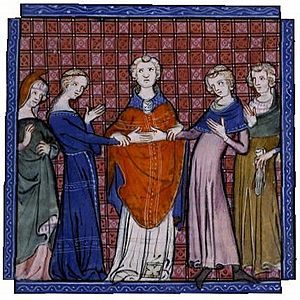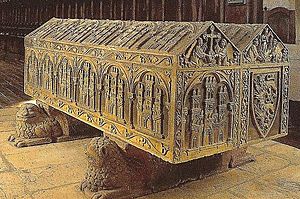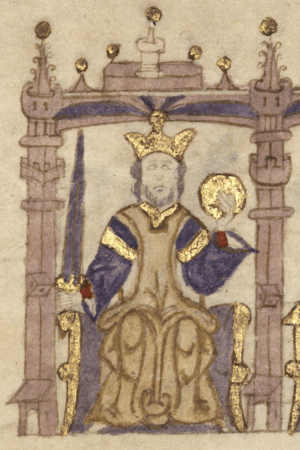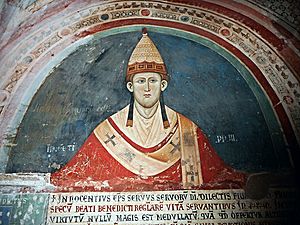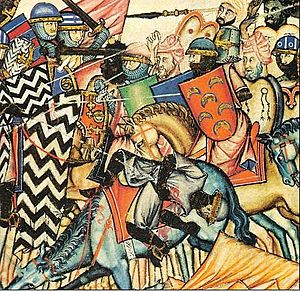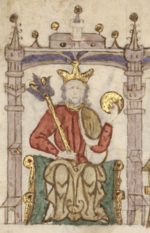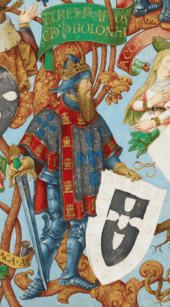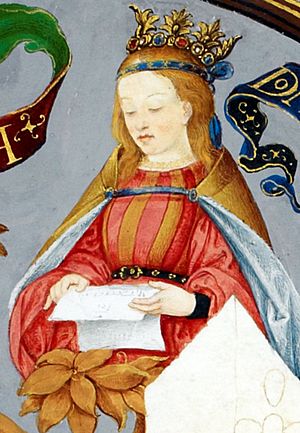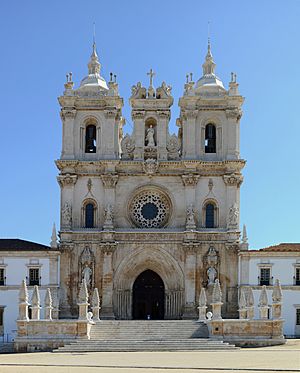Urraca of Castile, Queen of Portugal facts for kids
Quick facts for kids Urraca |
|
|---|---|
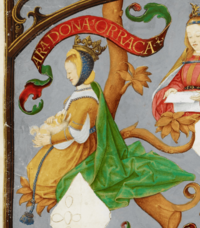
Urraca in Genealogy of the Kings of Portugal (António de Holanda, 1530–1534)
|
|
| Queen consort of Portugal | |
| Tenure | 26 March 1212 – 3 November 1220 |
| Born | 1186/28 May 1187 |
| Died | 3 November 1220 Coimbra, Kingdom of Portugal |
| Burial | Alcobaça Monastery |
| Spouse | Afonso II of Portugal |
| Issue | Sancho II of Portugal Afonso III of Portugal Eleanor, Queen of Denmark Fernando, Lord of Serpa |
| House | Castilian House of Ivrea |
| Father | Alfonso VIII of Castile |
| Mother | Eleanor of England |
| Religion | Roman Catholicism |
Urraca of Castile (born 1186 or 1187 – died 1220) was a princess who became the Queen of Portugal. She was the daughter of Alfonso VIII of Castile and Eleanor of England. Her grandparents were Henry II of England and Eleanor of Aquitaine.
Early Life of Queen Urraca
Family and Childhood
Urraca was born in 1187. She was the second daughter of King Alfonso VIII of Castile and Queen Eleanor of England. Her parents had many children, but only six lived to adulthood. Urraca's older sister was Berenguela, and her younger sisters were Blanche and Elenor. She also had two brothers, Ferdinand and Henry, who both died before they could become king.
In Castile, boys were usually chosen to rule before girls. Since Urraca was not a boy and not the oldest daughter, she was not expected to become Queen of Castile. However, royal daughters were still very important. They could marry kings from other countries, which helped their family gain power and make alliances.
Early Mentions and Betrothals
Urraca is first mentioned in a document from 1187 about the Las Huelgas monastery in Burgos. When she was a baby, Urraca was promised in marriage to the future King Alfonso IX of León. This was a common practice to create peace between kingdoms. However, Urraca and Alfonso IX never married. He later married Urraca's sister, Berenguela.
Royal mothers often had nursemaids help care for their children. Urraca's nursemaid was a woman named Sancha. This shows that Urraca's parents, the King and Queen, were very involved in raising their children, especially their sons, to prepare them for future roles.
Marriage to Afonso II of Portugal
Urraca married Afonso II, the King of Portugal, in 1205. This marriage helped keep peace between the kingdoms of Portugal and Castile. After her marriage, Urraca moved to Portugal. Afonso II became king in 1211.
Urraca's sisters also had important marriages. Blanca married the heir to the French throne, and Leonor married the heir to the Aragon throne. These marriages helped the Castilian royal family build strong connections across Europe.
Queenship in Portugal
Challenges for King Afonso II
Urraca's time as Queen of Portugal was busy due to her husband King Afonso II's challenges. When Afonso's father, King Sancho I, died, he left large estates and castles to his three eldest daughters: Teresa, Sancha, and Mafalda. This was a tradition in Portugal, where royal women often held important property.
Afonso II did not agree with his father's will. He believed that as king, he should control all royal lands. This disagreement led to a civil war between Afonso and his sisters. His sisters locked themselves in their castles and gathered supporters to defend their rights.
Both Afonso and his sisters asked Pope Innocent III to decide who was right. The Pope first sided with the sisters, saying they could keep their inherited lands. However, the conflict continued. Afonso's sister Teresa, who was married to King Alfonso IX of Leon, even got her husband to help her fight against Afonso II.
Urraca's Role as Queen
Urraca's marriage to Afonso II was very important during this time. It gave Afonso strong ties to the powerful Castilian kingdom. This helped him against his sisters, who had allied with the kingdom of Leon. The marriage helped bring peace between Portugal and Castile.
As Queen, Urraca's name was included in official documents issued by the King. This showed her role in the government as the King's wife. However, her role was not as powerful as some of her sisters-in-law, who were seen as queens in their own right because of the lands they inherited.
Urraca's main role was to have children to continue the royal family. She had four children: Sancho II (born 1207), Afonso III (born 1210), Eleanor (born 1211), and Ferdinand (born 1218). King Afonso II trusted Urraca greatly. In 1214, he named her Queen Regent for their son Sancho II, meaning she would rule if Afonso died before Sancho was old enough.
Involvement in the Reconquista
During Urraca's time as Queen, Portugal was also involved in the "Reconquista". This was a long period of wars where Christian kingdoms in Spain and Portugal fought to take back land from Muslim rulers. Afonso II fought alongside Urraca's father, Alfonso VIII, in the important Battle of Las Navas de Tolosa in 1212. This battle greatly weakened the Muslim kingdom in southern Spain.
Conflicts with the Catholic Church
Afonso II and Urraca's reign also saw conflicts with the Catholic Church. Portugal's first king, Afonso Henriques, had worked closely with the Church to gain Portugal's independence. His son, Sancho I, had given the Church land and rights to keep good relations.
However, Afonso II wanted to take back some of these lands and strengthen the power of the crown. This led to disagreements with the Church and the Pope. Afonso II was even excommunicated (removed from the Church) in 1219. Despite this, his actions helped create a stronger government in Portugal. During their reign, Portugal also created its first written laws about property and justice.
Legacy of Queen Urraca
Urraca died on November 3, 1220, at the age of 33 or 34. Her reign as Queen of Portugal was short, but she played an important role in a time when Portugal was growing as a new independent kingdom.
Her Children's Lives
Urraca and Afonso II had four children who became important figures in history.
Sancho II of Portugal
Sancho II of Portugal, born in 1209, was Urraca's oldest son. He became king at age 13 after his father died in 1223. Sancho wanted to be seen as a strong leader and a defender of the Christian faith. He fought against Muslim forces in the south of Portugal. Like his mother, Sancho II understood the importance of gaining support from the Pope.
Sancho II later faced challenges, including a conflict with his brother Afonso. He also married a noblewoman named Mécia Lopes de Haro, which caused a scandal due to their family ties. The Pope eventually ordered their marriage to be annulled. Sancho II was removed from power in 1248 and died in exile in Spain.
Afonso III of Portugal
Afonso III of Portugal, born in 1210, was Urraca's second son. He spent much of his youth in France with his mother's sister, Blanche of Castile, who was Queen of France. This strong connection to his mother's family was important for him.
Afonso returned to Portugal when his brother, King Sancho II, faced problems. In 1248, Afonso became regent and later king. He worked to improve Portugal, founding monasteries and nunneries, which earned him respect. Afonso also completed the "Reconquista" in Portugal, taking back more land from Muslim control. He died in 1279 at age 68.
Eleanor of Portugal, Queen of Denmark
Eleanor of Portugal, born around 1211, was Urraca's only daughter. Like her mother, not much is known about her life because she died young. At age 18, Eleanor married Valdemar the Young, the son of King Valdemar II of Denmark, in 1229. She died two years later, in 1231, during childbirth, at the age of 19 or 20. Eleanor was buried in St. Bendt's Church in Ringsted, Denmark.
Fernando, Lord of Serpa
Fernando, born in 1217, was the youngest child of Urraca and Afonso II. He was given the titles Lord of Serpa and Lord of Lamego. Fernando led troops and helped his brother, King Sancho II, in the "Reconquista". However, he was known for being violent and was even excommunicated from the Church in 1237. Fernando later sought forgiveness in Rome. He died in 1246 at the age of 29.
Burial Place
Queen Urraca of Castile is buried with her husband, King Afonso II of Portugal, at Alcobaça Monastery in Alcobaça, Portugal. Their son, Afonso III, and his second wife are also buried there. While many of Urraca's Castilian family are buried in the Las Huelgas monastery in Spain, it was common for queens to be buried with their husbands.
The Alcobaça Monastery was founded by King Afonso I of Portugal, Urraca's husband's grandfather, in 1153. It was given to the Cistercian monks, the same religious group that lived in Las Huelgas. The monastery looks much the same today as it did during Urraca's lifetime.
There are no clear pictures of Urraca's tomb. However, her coffin likely looks similar to others in Alcobaça Monastery, which feature detailed carvings. For example, the tomb of Urraca's daughter-in-law, Beatrice of Castile, has complex carvings of men and a relief of Beatrice. The monastery also holds the impressive tombs of King Pedro I and his mistress, Inês de Castro, which are beautiful examples of Gothic art.
Issue
- Sancho II of Portugal
- Afonso III of Portugal
- Eleanor of Portugal, Queen of Denmark
- Fernando, Lord of Serpa
See also
 In Spanish: Urraca de Castilla (reina de Portugal) para niños
In Spanish: Urraca de Castilla (reina de Portugal) para niños


